


RAH-66 Comanche
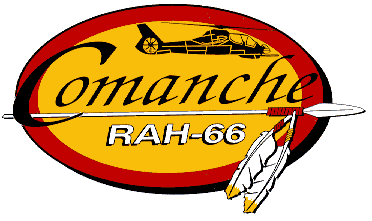 The Boeing-Sikorsky RAH-66 Comanche is the Army's next generation armed
reconnaissance helicopter. It also is the first helicopter developed
specifically for this role. The Comanche will provide Army Aviation the
opportunity to move into the 21st century with a weapon system of unsurpassed
warfighting capabilities crucial to the Army's future strategic vision.
The Comanche is intended to replace the current fleet of AH-1 and OH-58 helicopters in all air cavalry troops and light division attack helicopter battalions, and supplement the AH-64 Apache in heavy division/corps attack helicopter battalions.
The Boeing-Sikorsky RAH-66 Comanche is the Army's next generation armed
reconnaissance helicopter. It also is the first helicopter developed
specifically for this role. The Comanche will provide Army Aviation the
opportunity to move into the 21st century with a weapon system of unsurpassed
warfighting capabilities crucial to the Army's future strategic vision.
The Comanche is intended to replace the current fleet of AH-1 and OH-58 helicopters in all air cavalry troops and light division attack helicopter battalions, and supplement the AH-64 Apache in heavy division/corps attack helicopter battalions.
The first Boeing-Sikorsky RAH-66 Comanche prototype was rolled-out
at Sikorsky Aircraft, Stratford, Connecticut, May 25, 1995. The prototype's
first flight was made on 04 January 1996. The second prototype is scheduled to fly in late March 1999. Six early operational capability aircraft are
scheduled to be delivered 2002 to participate in an Army field exercise
in 2002-2003, or possibly later in "Corps 04". The Comanche is
powered by two Light Helicopter Turbine Engine Co. (LHTEC) T800-801
engines. These advanced engines and a streamlined airframe will be enable the Comanche to fly significantly faster than the larger AH-64 Apache.
The RAH-66 Comanche helicopter's primary role will be to seek out enemy
forces and designate targets for the AH-64 Apache Attack
helicopter at night, in adverse weather, and in battlefield obscurants,
using advanced infrared sensors. The helmet has FLIR images and overlaid
symbology that can be used as a headup display in nape-of-the-earth
(NOE) flight.
The aircraft has been designed to emit a low-radar signature (stealth features). The Comanche will perform the
attack mission itself for the Army's light divisions. The RAH-66 will be used as a scout and attack helicopter to
include an air-to-ground and air-to-air combat capability. The Comanche is slated to replace the AH-1 Series
Cobra light attack helicopter, the OH-6A Cayuse, and the OH-58A/OH-58C Kiowa light observation
helicopters.
The Comanche mission equipment package consists of a turret-mounted cannon,
night-vision pilotage system, helmet-mounted display, electro-optical target
acquisition and designation system, aided target recognition, and integrated
communication/navigation/identification avionics system. Targeting includes a
second generation forward-looking infrared (FLIR) sensor, a low-light-level
television, a laser range finder and designator, and the Apache Longbow
millimeter wave radar system. Digital sensors, computers and software will
enable the aircraft to track and recognize advesarys long before they are
aware of the Comanche's presence, a key advantage in both the reconnaissance
and attack roles.
Aided target detection and classification software will automatically scan
the battlefield, identifying and prioritizing targets. The target acquisition
and communications system will allow burst transmissions of data to other
aircraft and command and control systems. Digital communications links will
enable the crew unparalleled situational awareness, making the Comanche an
integral component of the digital battlefield.
The armament subsystems consist of the XM301 20mm cannon, and up to
14 Hellfire anti-tank missiles, 28 Air-to-Air Stinger (ATAS) anti-aircraft
missiles, or 56 2.75 inch Hydra 70 air-to-ground rockets carried internally
and externally. Up to four Hellfire and two Air-to-Air Stinger (ATAS) missiles
can be stowed in fully-retractable weapons bays and the gun can be rotated to
a stowed position when not in use. This design feature reduces both drag and
radar signature.
Mission management, status, and control information is provided over the
MIL-STD-1553B databus between the mission equipment packages and the
Turreted Gun System. The Comanche will have enhanced maintainability through
it's modular electronics architecture and built-in diagnostics.
RAH-66 COMANCHE CAPABILITIES
Sensors and avionics. In the reconnaissance role, the Comanche will
be equipped with a new generation of passive sensors and a fully integrated
suite of displays and communications. Advance infrared (IR) sensors will have
twice the range of OH-58D Kiowa Warrior and AH-64 Apache sensors. The Comanche
will be equipped with the Apache Longbow fire control radar and the Helmet
Integrated Display and Sight System (HIDSS). The fully integrated avionics
system will allow tactical data to be overlaid onto a digital map, allowing
the crew to devote more time for target detection and classification. A
triple-redundant fly-by-wire system can automatically hold the helicopter in
hover or in almost any other maneuver, reducing workload, allowing the pilot
to concentrate on navigation and threat avoidance. A hand-on grip permits
one-handed operation.
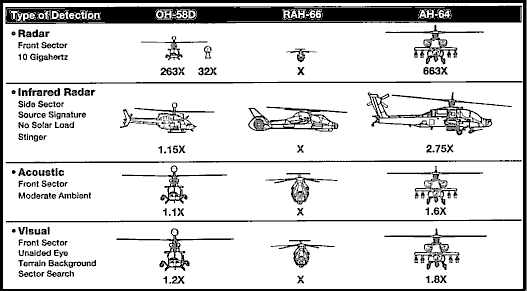
Stealth characteristics. The Comanche incorporates more low-observable
stealth features than any aircraft in Army history. The Comanche radar cross-section
(RCS) is less than that of a Hellfire missile. To reduce radar cross-section,
weapons can be carried internally, the gun can be rotated aft and stowed
within a fairing behind the turret when not in use, and the landing gear are
fully-retractable. The all-composite fuselage sides are flat and canted and
rounded surfaces are avoided by use of faceted turret and engine covers. The
Comanche's head-on RCS is 360 times smaller than the AH-64 Apache, 250 times
less than the smaller OH-58D Kiowa Warrior, and 32 times smaller than the
OH-58D's mast-mounted sight. This means the Comanche
will be able to approach five times closer to an enemy radar than an Apache,
or four times closer than an OH-58D, without being detected.
Noise suppression. The Comanche only radiates one-half the rotor noise
of current helicopters. Noise is reduced by use of a five-bladed rotor, pioneered
by the successful Boeing (McDonnell Douglas) MD-500 Defender series of light
utility helicopters. The fantail eliminates interaction between main rotor and
tail rotor wakes. The advanced rotor design permits operation at low speed,
allowing the Comanche to sneak 40% closer to a target than an Apache, without
being detected by an acoustical system.
Infrared (IR) suppression. The Comanche only radiates 25% of the
engine heat of current helicopters, a critical survivability design concern in
a low-flying tactical scout helicopter. The Comanche is the first helicopter in
which the infrared (IR) suppression system is integrated into the airframe. This
innovative Sikorsky design feature provides IR suppressors that are built into
the tail-boom, providing ample length for complete and efficient mixing of engine
exhaust and cooling air flowing through inlets above the tail. The mixed exhaust
is discharged through slots built into an inverted shelf on the sides of the
tail-boom. The gases are cooled so thoroughly that a heat-seeking missile cannot
find and lock-on to the Comanche.
Crew Protection. The Comanche features a crew compartment sealed for
protection against chemical or biological threats, an airframe resilient against
ballistic damage, enhanced crash-worthiness, and reduced susceptibility to
electromagnetic interference.
Maintainability Comanche will be easily sustained, will require fewer personnel and support equipment, and will provide a decisive battlefield capability
in day, night and adverse weather operations. Comanche has been
designed to be exceptionally maintainable and easily transportable. Through its keel-beam construction, numerous access panels, easily accessible line-replaceable units/modules and advanced diagnostics, the RAH-66 possesses
"designed-in" maintainability. Comanche aircraft will be able to be rapidly loaded into or unloaded from any Air Force transport aircraft.
Specifications
|
|
|
| Manufacturer | Boeing Helicopter Company and
Sikorsky Aircraft Division (joint venture)
|
|
Length | 46.78 feet (rotor turning)
|
|
Width | 39.04 feet (rotor turning)
|
|
Height | 11.0 feet (overall)
|
|
Armament |
Air-to-air Stinger
Hellfire
20mm three-barrel turreted gun
Hydra-70 rockets
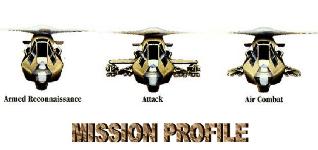
|
|
Weight |
Empty 7,765 pounds
Combat Mission 10,600 pounds
|
|
Mission Equipment |
Centralized processing architecture with Ada software
Target acquisition system with
aided-target detection/classification and automatic target tracking;
night vision pilotage
system, wide field-of-view (35ox52o) helmet-mounted display
|
|
Propulsion | Two T800 1,440
SHP gas turbine engines
5-blade main rotor
Fantail anti-torque
|
| Crew | Two
|
| Speed |
330 km/hr / 172 knots - Dash speed
315 km/hr / 164 knots - Dash speed
(@ 4,000 feet/95oF / with Longbow)
310 km/hr / 161 knots - Cruise speed
|
|
Vertical Rate of Climb | 500-850 feet per minute
|
| Range |
262 nm Max Range (internal fuel)
1,260 nm self-deployment range
|


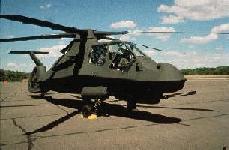


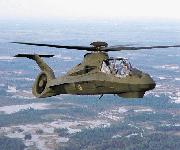
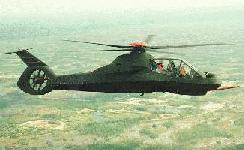
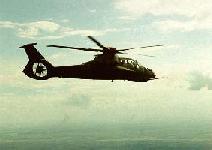
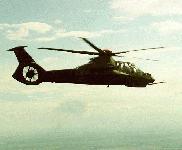
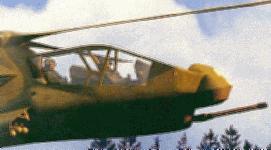
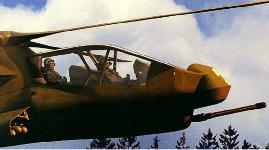
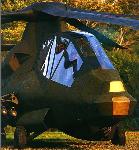

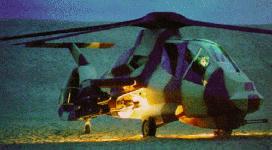
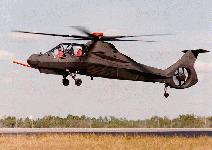
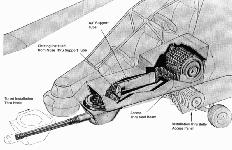

Sources and Resources
http://www.fas.org/man/dod-101/sys/ac/rah-66.htm
Maintained by Robert Sherman
Originally created by John Pike
Updated Friday, March 12, 1999 5:54:08 PM
 The Boeing-Sikorsky RAH-66 Comanche is the Army's next generation armed
reconnaissance helicopter. It also is the first helicopter developed
specifically for this role. The Comanche will provide Army Aviation the
opportunity to move into the 21st century with a weapon system of unsurpassed
warfighting capabilities crucial to the Army's future strategic vision.
The Comanche is intended to replace the current fleet of AH-1 and OH-58 helicopters in all air cavalry troops and light division attack helicopter battalions, and supplement the AH-64 Apache in heavy division/corps attack helicopter battalions.
The Boeing-Sikorsky RAH-66 Comanche is the Army's next generation armed
reconnaissance helicopter. It also is the first helicopter developed
specifically for this role. The Comanche will provide Army Aviation the
opportunity to move into the 21st century with a weapon system of unsurpassed
warfighting capabilities crucial to the Army's future strategic vision.
The Comanche is intended to replace the current fleet of AH-1 and OH-58 helicopters in all air cavalry troops and light division attack helicopter battalions, and supplement the AH-64 Apache in heavy division/corps attack helicopter battalions.





















